|
Related FAQs: Sea
Urchins, Urchins 2, Urchins 3, Urchin Identification, Urchin Behavior, Urchin Compatibility, Urchin Selection, Urchin System, Urchin Feeding, Urchin Disease, Urchin Reproduction,
Related Articles: Echinoderms, An Introduction to the
Echinoderms: The Sea Stars, Sea Urchins, Sea Cucumbers and
More... By James W. Fatherree, M.Sc. Algae Control, Nutrient Control and
Export,
/A Diversity of Aquatic
Life
Some Spines
Now! Sea Urchins (and Sand Dollars), the Echinoids, Pt.
2
To:
Part 1, Part 3,
Part 4, Part 5,
Part 6
|
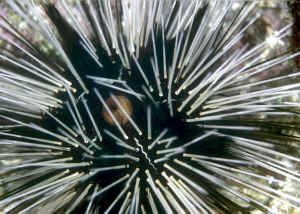
|
|
By Bob Fenner
|
Echinothrix calamaris
|
Genus Diadema:
| Diadema antillarum, the Long-Spined Urchin.
Tropical West Atlantic. 4-8 inch diameters with spines. Come out at
night to feed, hide during the day within rock crevices. Younger
ones with white banded spines. Cozumel images during the night and
a juvenile showing white and black spine banding in
Bonaire. |
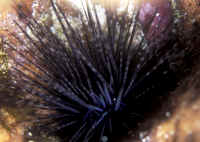 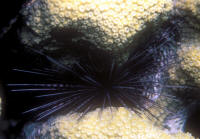
|
Bigger PIX:
The images in this table are
linked to large (desktop size) copies. Click on "framed"
images to go to the larger size. |
%20MD.jpg)
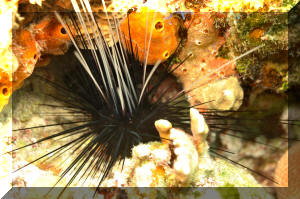
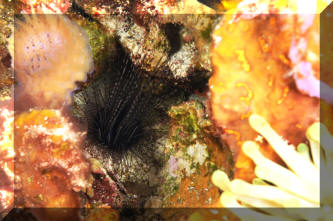
%20MD.JPG)
%20MD.JPG) |
| Diadema mexicanum A. Agassiz 1863, Needle
Sea Urchin. Costa Rica (Pacific side)
2011 |
%20MD.JPG)
|
Bigger PIX:
The images in this table are linked to large
(desktop size) copies. Click on "framed" images to go to
the larger size. |
|
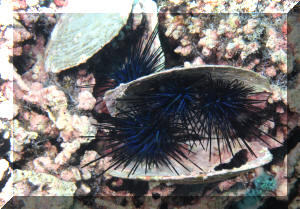
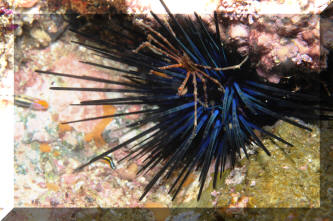
|
| Diadema paucispinum (A. Agassiz 1863), a
Long-Spined Sea Urchin. Pacific; Hawai'i and islands of the
South Pacific. To about twelve inches maximum diameter, with
spines. Usually in 60 or more feet of water on a vertical surface.
Common name means "few spines" which you may not agree
with if you get poked but good. Kona pix. |
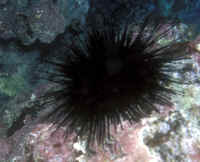
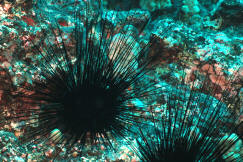
|
Bigger PIX:
The images in this table are linked
to large (desktop size) copies. Click on "framed" images
to go to the larger size. |
|
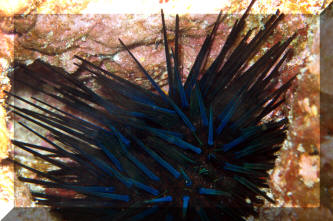
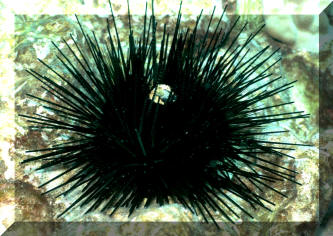
|
| Diadema savignyi (Michelin 1845), a
Long-Spined Sea Urchin. Indo-Pacific; Africa to the South Pacific.
Test about five inches maximum diameter, with spines to sixteen.
Black, grey, brown in color. Have green to blue lines in their
interambulacral aborally (on top). Lack the orange ring around the anus of
D. setosum (below). Hide in shade by day, scouring the reefs by night. Blue ring around
anus is indicative of this species. A frequent contaminant on/in
live rock imports. Tiny aquarium individual and Philippines one
shown. |
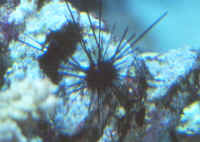
|
| Diadema setosum (Leske 1778), the Hatpin
Urchin. Indo-Pacific; Red Sea to South Pacific, Japan. To about
four inches in diameter. Useful in coral bearing aquariums as these
echinoids avoid their rocks. A frequent "contaminant" on
live rock imports. Painful to get stuck by... Red ring around anus and five
white dots are definitive. Fiji nighttime image and N. Sulawesi by
day. |
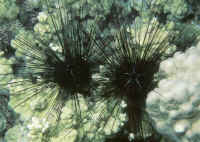 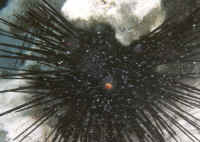
|
Bigger PIX:
The images in this table are linked
to large (desktop size) copies. Click on "framed" images
to go to the larger size. |
|
%20MD.JPG)

|
To:
Part 1, Part 3,
Part 4, Part 5,
Part 6
|
|

